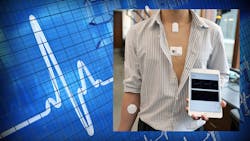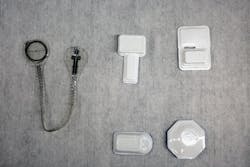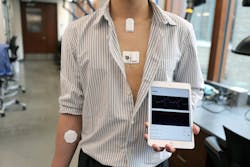On-demand Transient Pacemaker Communicates Through Sensors
Northwestern University researchers have upped the ante with a smart pacemaker device that continuously monitors physiological functions such as oxygen levels, respiration, muscle tone, physical activity and the heart’s electrical activity.
An upgrade from a transient pacemaker developed in 2021, the implantable device is designed for patients who need temporary pacing after cardiac surgery or are waiting for a permanent pacemaker.
The latest iteration benefits from an automation feature that enables on-demand pacing. Sensors placed at specific points on the body communicate with each other and that data is fed to algorithms, which then analyze the combined activity in order to detect abnormal cardiac rhythms. The information is streamed to a smartphone or tablet so that physicians can remotely monitor their patients.
The integrated system consists of a transient, bioresorbable pacemaker; a cardiac module that sits on the chest; and a network of wearable sensors, including:
- A hemodynamics module that is placed on the forehead to sense pulse oximetry, tissue oxygenation and vascular tone;
- A respiratory module that sits at the base of the throat to monitor coughing and respiratory activity; and
- A multi-haptic-feedback module that vibrates and pulses in a variety of patterns to communicate with the patient.
The research team explained in a press release that the chest-mounted cardiac module syncs with the pacemaker to record an electrocardiogram in real time to monitor heart activity. The pacemaker wirelessly harvests energy from the small wireless device that adheres to the patient’s chest without needing sutures. The transient pacemaker eventually dissolves, noted the researchers, but not before releasing an anti-inflammatory drug to prevent foreign-body reactions.
Northwestern University’s John A. Rogers stated in the press release that this work marked the first time the research team had paired soft, wearable electronics with transient electronic platforms. “This approach could change the way patients receive care providing multi-nodal, closed-loop control over essential physiological processes—through a wireless network of sensors and stimulators that operates in a manner inspired by the complex, biological feedback loops that control behaviors in living organisms,” Rogers said.
The study, “A transient, closed-loop network of wireless, body-integrated devices for autonomous electrotherapy,” was published in the journal Science. The research was led by Northwestern’s John A. Rogers, Igor R. Efimov and Dr. Rishi Arora.
Click here for footage of the devices off the body in the lab, being placed onto a volunteer and then removed. (Courtesy Northwestern University)
About the Author

Rehana Begg
Editor-in-Chief, Machine Design
As Machine Design’s content lead, Rehana Begg is tasked with elevating the voice of the design and multi-disciplinary engineer in the face of digital transformation and engineering innovation. Begg has more than 24 years of editorial experience and has spent the past decade in the trenches of industrial manufacturing, focusing on new technologies, manufacturing innovation and business. Her B2B career has taken her from corporate boardrooms to plant floors and underground mining stopes, covering everything from automation & IIoT, robotics, mechanical design and additive manufacturing to plant operations, maintenance, reliability and continuous improvement. Begg holds an MBA, a Master of Journalism degree, and a BA (Hons.) in Political Science. She is committed to lifelong learning and feeds her passion for innovation in publishing, transparent science and clear communication by attending relevant conferences and seminars/workshops.
Follow Rehana Begg via the following social media handles:
X: @rehanabegg
LinkedIn: @rehanabegg and @MachineDesign


